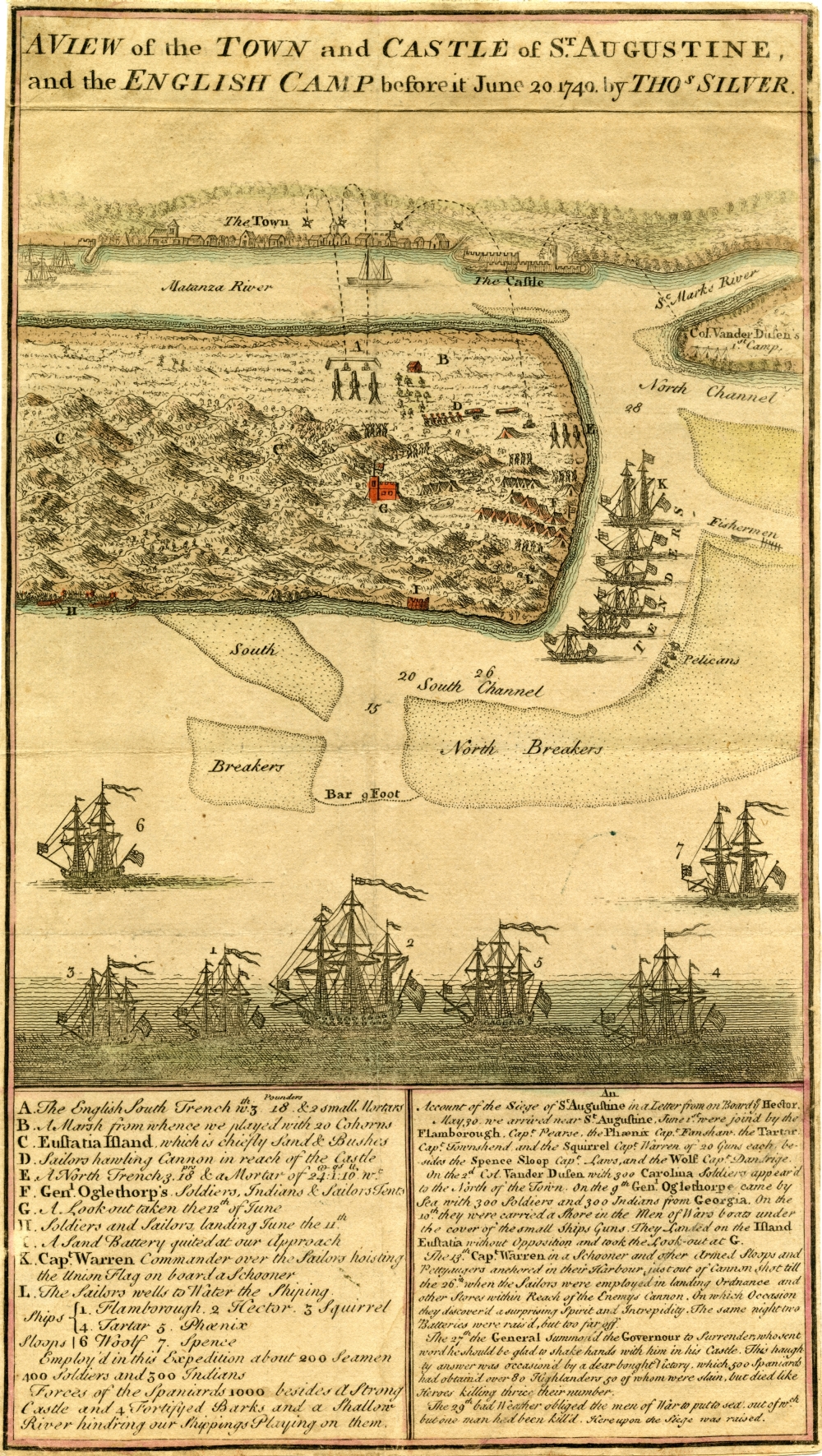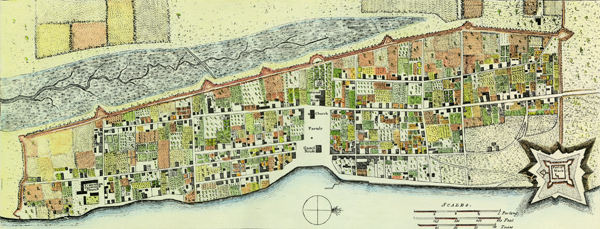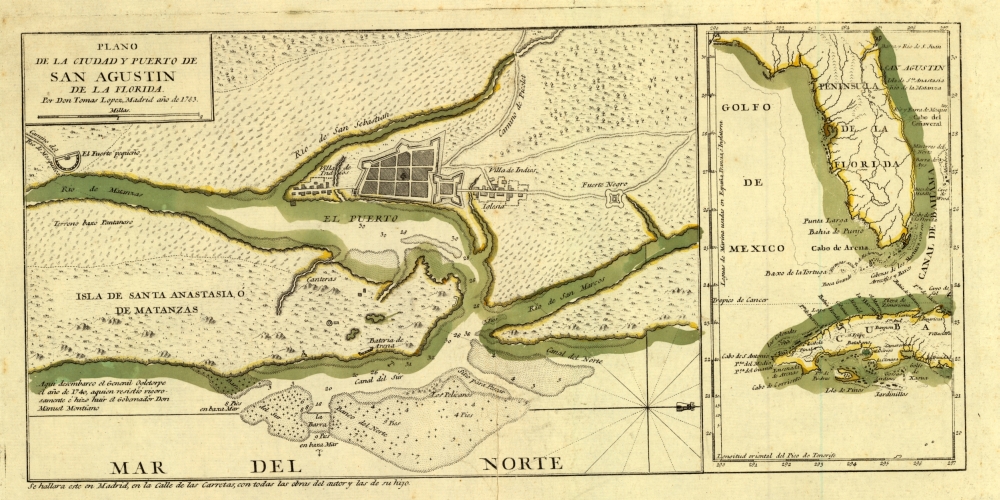Description of previous item
Description of next item
The British Invasion
Published June 6, 2013 by Florida Memory
The War of Jenkins' Ear (1739-1748) was but a single episode in the prolonged series of imperial conflicts between England and Spain in the 18th century. In the summer of 1740, the conflict came to Florida.
In 1731, Spanish coast guardsmen boarded an English merchant ship captained by Robert Jenkins. The Spaniards accused the Englishmen of smuggling, and as punishment cut off Jenkins' ear. According to some accounts, Jenkins later exhibited the severed ear in front of the British Parliament during his testimony on Spanish depredations. This incident, along with numerous petitions and lengthy testimony, convinced the British government to take action against Spain.
War erupted across the Caribbean soon after the hearings before Parliament. The most significant action in Florida resulted from an expedition led by General James Oglethorpe against the city of St. Augustine in the summer of 1740. By all accounts, Oglethorpe's campaign constituted an epic failure. The General Assembly of South Carolina launched a full investigation into the failed siege. Ultimately, they concluded that a series of tactical mistakes doomed the English effort to weaken the Spanish outpost.
English cartographer Thomas Silver created the map below to illustrate the siege against St. Augustine. It bears a striking resemblance to a map depicting an earlier British attempt to level St. Augustine, undertaken by Sir Francis Drake in 1586. The transcription of the long key included with the map has, as much as possible, preserved spellings used in the original.
Transcription of Silver's Map:
"A View of the Town and Castle of St. Augustine, and the English Camp before it June 20, 1740. By Thos. Silver.
A. The English South Trench [?] 3 18 Pounders & 2 small Morters
B. A Marsh from whence we played with 20 Cohorns
C. Eustatia Island, which is chiefly Sand & Bushes
D. Sailors hawling Cannon in reach of the Castle
E. A North Trench 3 18 prs & a Mortar of 24:1:10
F. Genl. Oglethrop's Soliders, Indians & Sailors Tents
G. A Lookout taken the 12th of June
H. Soldiers and Sailors landing June the 11th
I. A Sand Battery quited at our Approach
K. Capt. Warren Commander over the Sailors hoisting the Union Flag on board a Schooner
L. The Sailors wells to Water the Shiping
Ships 1. Flamborough 2. Hector 3. Squirrel
4. Tartar 5. Phoenix
6. Woolf 7. Spence
Employ'd in this Expedition about 200 Seamen 400 Sailors and 300 Indians
Forces of the Spaniards 1000 besides a Strong Castle and 4 Fortified Barks and a Shallow River hindring our Shippings Playing on them.
An Account of the Siege of St. Augustine in the letter on Board ye Hector. May 30 we arrived near St. Augustine, June 1st we were join'd by the Flamborough. Capt. Pearse, the Phoenix Capt. Fanshaw, the Tartar Capt. Towshend and the Squirrel Capt. Warren of 20 Guns each besides the Spense Sloop Capt Laws, and the Wolf Capt. Dandrige.
On the 2d Col Vander Dufen with 300 Carolina Soldiers appear'd on the North of the Town. On the 9th Genl. Oglethorpe came by Sea with 300 Soldiers and 300 Indians from Georgia. On the 10th they were carried a Shore in the Men of Wars boats under the cover of the small Ships Guns. They Landed on the Island Eustatia without Opposition and took the Look-out at G.
The 13th Capt. Warren in a Schooner and other Armed Sloops and Pettyaugers anchored in their Harbor just out of Cannon shot till the 26th when the Sailors were employed in landing Ordnance and other Stores within Reach of the Enemys Cannon. On which Occasion they discover'd a surprising Spirit and Intrepidity. The same night two Batteries were rais'd, but too far off.
The 27th the General Summon'd the Governor to Surrender, who sent word he should be glad to shake hands with him in his Castle. This haughty answer was occasioned by a dear bought Victory, which 500 Spaniards had obtained over 80 Highlanders 50 of whom were slain, but died like Heroes killing thrice their number.
The 29th bad Weather obliged the men of War to put to sea out of [?] but one man had be kill'd. Hereupon the Siege was raised."
James Oglethorpe, English military commander and founder of the Georgia colony, led the expedition against St. Augustine. In January 1740, Oglethorpe presented his plan for a swift victory before the South Carolina General Assembly. He envisioned a decisive surprise attack led by English soldiers and militia, aided by Creek and Cherokee warriors.
Surprise proved nearly impossible for the English invaders. Leading up to the advance of the main force, England's Native American allies–principally Creek and Euchee (also Yuchi) warriors–periodically raided Spanish settlements north of St. Augustine. An incident on Amelia Island in late 1739 also alerted the Spaniards to the likelihood of an attack.
By the time Oglethorpe's army reached the south bank of the St. Johns River on May 9, 1740, the Spanish were certainly aware of their intentions. On May 12, Oglethorpe took Fort Diego, located 20 miles north of St. Augustine near the head of the Tolomato River. Four days later he advanced on St. Augustine, but pulled back to Fort Diego on May 18. At this point, several commanders expressed dissatisfaction with Oglethorpe's tactics. Some questioned why he did not immediately besiege the town as Colonel James Moore had done with great success four decades earlier.
During the ensuing month, Oglethorpe repeatedly marched his troops within sight of the city without launching a full assault. Regular soldiers, militia, and Indian auxiliaries again lodged complaints about the incessant and seemingly pointless marching. A group of Creeks even threatened to abandon the field, and apparently some did. Oglethorpe also divided his force, weakening their ability to defend any particular position. He left some men at Fort Diego, sent a group across the bay to Anastasia Island, and encamped another on Point Quartell (modern-day Vilano Beach).
After much maneuvering on the English side, the most significant battle of the campaign took place in the early morning hours of June 15 (modern calendar June 26). A company of Scottish Highlanders and a number of Creeks had occupied the abandoned Fort Mose north of St. Augustine. Fort Mose was established in 1739 to defend the northern approach to the city; its defenders were free-blacks and escaped slaves organized into a militia unit. The African defenders of Fort Mose had left the four-square wooden and earthen structure in anticipation of Oglethorpe's advance on the city, which never fully materialized aside from sporadic artillery fire.
"Plano de la Ciudad y Puerto de San Agustin de la Florida" by Tomas Lopez de Vargas Machura, 1783. The location of Fort Mose is noted on this map as "Fuerte Negro."
Colonel Palmer, commanding the troops at Mose, warned the men to be on alert the evening of the 14th. He reportedly had heard "Spanish Indians dancing the War Dance." Apparently the soldiers did not heed his call for vigilance and when the combined force of Spanish soldiers, African militia under the command of free-black Francisco Menendez, and Indian warriors attacked the fort, they easily routed the Highlanders and Creeks inside.
Conflicting reports surfaced on English causalities suffered at the Battle of Bloody Mose, as the event became known. Oglethorpe reported 20 Highlanders killed, plus "several Indians and some Others" as well as 27 taken prisoner. Thomas Jones, a Creek interpreter, counted "about fifty Whites and Indians" killed in the action. Jones also added gruesome details about the aftermath of the battle. "[A]fter their Victory at Moosa," he explained, the victors "cut off the Heads and private Parts of the Slain, and carried them into Augustine in Triumph."
The Battle of Bloody Mose proved to be a turning point in the siege. In the weeks that followed, Oglethorpe proved incapable of rallying his troops to the cause. By early July he had also lost the support of vessels patrolling the entrance to the Matanzas River. Citing possible hurricanes ships left the area, which allowed the Spanish to easily resupply the besieged settlement. By mid-July the English retreated and St. Augustine survived another British invasion.
The subsequent investigation by the General Assembly of South Carolina enumerated at length the failures of Oglethorpe's expedition. First, unrestrained attacks by England's Indian allies as well as preemptive raids near Amelia Island spoiled the element of surprise, long before the army marched into Florida. Second, the repeated marching and dividing of the troops without attacking weakened both morale and the potential for success. Third, several incidents alienated Oglethorpe's Indian allies, without whom victory was unlikely. Fourth, the Assembly did not feel as if they had been properly advised on critical decisions during the campaign; Oglethorpe had acted without their advice and paid for it in defeat. Finally, the departure of the blockading vessels in early July dealt the final blow to an ill-conceived and poorly executed mission.
Ironically, Great Britain did gain control of St. Augustine 23 years later in 1763, following the end of the French and Indian War (1754-1763), also known as the Seven Years War. This time, a bloodless transfer took place and the British finally breached the city walls and entered the Castillo de San Marcos as victors.
To learn more about the British siege of St. Augustine in 1740, see Edward Kimber, A Relation, Or Journal, Of a Late Expedition &c (Gainesville: University Presses of Florida, 1976); John Tate Lanning, ed., The St. Augustine Expedition of 1740: A Report to the South Carolina General Assembly (Columbia: South Carolina Archives Department, 1954); and Aileen Moore Topping, ed., An Impartial Account of the Late Expedition Against St. Augustine under General Oglethorpe (Gainesville: University Presses of Florida, 1978).
Cite This Article
Chicago Manual of Style
(17th Edition)Florida Memory. "The British Invasion." Floridiana, 2013. https://www.floridamemory.com/items/show/259742.
MLA
(9th Edition)Florida Memory. "The British Invasion." Floridiana, 2013, https://www.floridamemory.com/items/show/259742. Accessed December 15, 2025.
APA
(7th Edition)Florida Memory. (2013, June 6). The British Invasion. Floridiana. Retrieved from https://www.floridamemory.com/items/show/259742

 Listen: The Latin Program
Listen: The Latin Program


